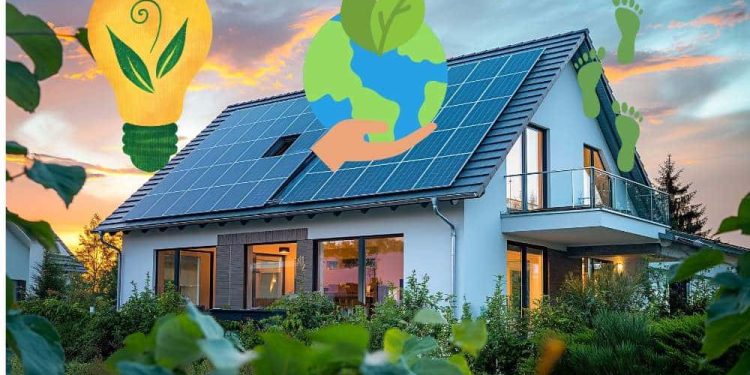Installing solar is often the turning point for an Australian home, that moment when clean energy becomes part of everyday life. But while the panels on your roof might get all the attention, they’re only one piece of a much larger sustainability story. The real gains often come from what happens inside the home: the small, often overlooked upgrades that quietly reduce waste, smooth energy demand, and stretch every kilowatt further.
Across the country, forward-thinking homeowners are discovering a new layer of eco-efficiency. Some are borrowing infrared cameras from local councils to hunt down heat leaks, while others are installing solar-powered roof ventilators or experimenting with phase-change insulation that evens out indoor temperatures naturally. There aren’t headline-grabbing changes, but the kind of refinements that make a solar system work smarter, not harder.
Thermal tweaks
When you already produce your own electricity, the next logical step is to protect how you use it. Every draft, overheated roof cavity, or under-insulated wall quietly drains your solar gains. The good news? Small, smart adjustments can transform your home’s energy balance without expensive overhauls.
Thermal mapping
A surprising number of councils across Australia now lend out infrared cameras. These handheld devices reveal where heat escapes or cold air sneaks in (through window seals, roof cavities, or wall junctions). It’s a simple weekend project that costs nothing yet can save hundreds in future heating and cooling bills. Once you’ve identified leaks, targeted insulation or sealing is far more effective than guessing where to start.
Whirlybirds
Traditional roof ventilators have long helped homes breathe, but the new generation takes it further. Solar-powered whirlybirds actively extract hot air during the day, cutting roof temperatures dramatically, easing the load on air conditioning. They also help panels run more efficiently by keeping roof surfaces cooler, especially during summer peaks when every degree counts.
Phase-change insulation
Unlike bulk or reflective insulation, phase change materials (PCMs) absorb and store heat as they shift between solid and liquid states, then release it slowly as temperatures drop. They act as a thermal buffer, smoothing out daily temperature swings so your home stays comfortable longer without switching systems on and off. PCMs are particularly effective when paired with solar homes that experience strong daytime heat and cooler nights.
Honeycomb blinds
Beyond their aesthetics, honeycomb blinds are a clever, low-cost thermal upgrade. The cellular design traps air within each pocket, forming an extra layer of insulation over windows (one of the biggest heat loss and gain points in any home). When combined with double glazing or efficient window seals, they can reduce heating and cooling demand significantly, giving your solar power more room to work on what matters.
Retrofit smarter, not harder
Double glazing
Traditional double glazing can be costly, but new retrofit systems make it possible to upgrade existing windows without replacing the entire frame. Acrylic or glass inserts fit neatly onto current panes, sealing out drafts, and cutting noise while improving insulation performance. It’s an especially smart move for older homes that rely on heating and cooling systems powered by solar energy—less loss means more efficient use of what your panels generate.
Cool-roof coatings
Your roof doesn’t just hold the panels; it directly affects how well they perform. High temperatures can lower solar output, so reflective “cool roof” coatings are gaining traction across suburbs. Made from ceramic or polymer compounds, these coatings bounce back a significant portion of solar radiation, keeping the roof surface up to 30 °C cooler. The result? A more comfortable home interior and panels that maintain optimal efficiency through the harshest months.
Non-toxic paints
Low-VOC paints have become standard for indoor air quality, but the latest formulations go a step further. Brands such as ecolour and Haymes now produce paints infused with minerals like titanium dioxide that actively break down airborne pollutants under light exposure. It’s a subtle way to turn walls into passive air purifiers, a meaningful addition to solar homes already focused on healthier, cleaner living.
Water and waste: The circular home
Energy isn’t the only system a solar household can optimise. A truly sustainable home works in cycles—water feeds the garden, compost feeds the soil, and nothing valuable goes to waste. These circular upgrades are simple in concept but powerful in impact, especially when paired with the independence solar already provides.
Rainwater reuse that does more than water plants
Rainwater tanks are common across Australia, but their integration is often underused. When connected beyond garden hoses, such as toilets, washing machines, or irrigation timers, they can reduce mains water use by thousands of litres a year. Some households now add smart sensors that monitor levels and pump usage, ensuring the system always operates when the sun is shining and power is plentiful.
Composting that offsets carbon
Food scraps account for a large share of landfill emissions, but composting transforms them into a renewable soil booster. Modern systems like bokashi bins and worm farms fit well into urban homes or even apartments. Many councils offer rebates or free starter kits, recognising that composting isn’t just about waste reduction, but a form of carbon capture at the household scale.
Greywater systems for water-smart living
Installing a diverter that reroutes laundry or shower water to the garden can out potable water use by up to 30%. Some new models include built-in filters and drip-feed options that can connect directly to irrigation systems. Used wisely, these systems allow solar homeowners to time their watering cycles with daylight hours, when the energy to pump or filter is free.
Dual-flush toilets and low-flow fixtures aren’t new, but today’s designs strike a better balance between conservation and comfort. Replacing an older toilet can save over 10,000 litres of water per year, and low-flow shower heads often qualify for water efficiency rebates from state utilities like Sydney Water or SA Water.
Waste less, live smarter
Once a home generates its own clean energy, the next question is how to use it intelligently. Waste reduction isn’t just about what goes into the bin, but about eliminating silent drains on power, water, and materials. These small, behaviour-driven upgrades help make your solar energy work harder and last longer.
Smart power strips that think of you
Standby power can consume up to 10% of a household’s electricity use. Smart power strips fix that by cutting off the supply to devices when they’re inactive. The newest models can even “learn” your household habits, automatically disconnecting equipment at night or during work hours. Pair them with your solar monitoring app, and you can schedule nonessential loads around peak generation times, squeezing more out of your daytime output.
Native gardens that give back
Replacing lawns or imported plants with Australian natives isn’t just a landscaping choice, but a sustainability upgrade. Native gardens require less water, attract pollinators, and create cooler microclimates that reduce urban heat, a subtle way to support both your local ecosystem and your solar panels’ efficiency. Many councils even offer rebates for native replanting or habitat restoration projects.
Composting as a closed-loop system
If you’ve already adopted solar, composting is the next logical step to close. The key is choosing the right setup: outdoor bins for larger gardens, bokashi systems for compact kitchens, or worm farms for families producing regular organic waste. Not only does compost reduce landfill emissions, it turns what would have been waste into a renewable soil amendment, cutting the need for chemical fertilisers that have their own carbon footprint.
Recycling with purpose
Recycling rates in Australia have improved, but contamination remains a major issue. Setting up dedicated bins for glass, soft plastics, and e-waste ensures materials actually get reused. Some households are going further by joining community swap or repair programs, giving appliances and tools a second life rather than sending them to landfill.
Non-toxic and smarter interiors
A truly eco-friendly solar home doesn’t stop at panels, insulation, or water systems. It extends to the materials you live with every day. Interior upgrades can quietly improve air quality, reduce energy waste, and make your home healthier to inhabit. They’re often invisible, but their impact is lasting.
Sustainable flooring
Flooring has a large environmental footprint, but renewable materials like bamboo, cork, or reclaimed timber offer a cleaner alternative. These options are durable, easy to maintain, and help regulate indoor temperature naturally. For homes with solar underfloor heating or passive design layouts, sustainable flooring also improves heat retention, keeping living spaces comfortable without excess energy use.
Lighting that complements solar rhythms
While LED bulbs are standard, lighting placement and control systems can take efficiency further. Motion sensors, dimmable circuits, and smart switches linked to solar monitoring tools can adjust brightness automatically based on daylight levels. It’s another way to match usage with generation, ensuring that every light shines only when it’s needed.
Emerging upgrades to watch
As technology matures, a new wave of upgrades is giving homeowners even more control over how they store, share, and use energy. These aren’t distant concepts; many are already rolling out in pilot programs or early commercial releases across the country.
Thermal batteries for heat storage
Instead of storing electricity, thermal batteries store heat, often using materials like salt or graphite. During the day, excess solar power is converted into heat energy, which can later be released to warm water or living spaces overnight. They’re especially promising for off-grid or high-consumption households that want to reduce reliance on electric heating.
Across South Australia (SA) and Victoria (VIC), small neighbourhood microgrids are showing what shared energy can look like. These systems connect multiple solar homes into a local network that balances supply and demand automatically. When one home produces more than it needs, another draws on the excess. It’s decentralised energy at its most practical.
Recycled and regenerative building materials
Circular construction materials such as recycled glass insulation, hempcrete, and mycelium-based panels are redefining what sustainable housing looks like. These materials don’t just reduce embodied carbon. They actively regenerate air quality and temperature stability, extending the eco-friendly ethos of solar into the very structure of the home.
AI-driven energy optimisation
The next generation of home energy management systems will do more than schedule appliances; they’ll predict. Using local weather data and tariff forecasts, AI-powered systems can anticipate the best time to run energy-intensive devices, preheat water, or store energy for cloudy periods. It’s a hands-off way to maximise savings while easing pressure on the wider grid.
Sustainability doesn’t end with clean energy generation. A truly efficient home works as an ecosystem, one that traps heat wisely, purifies its own air, manages its own water, and uses every watt with intent. From infrared audits to reflective roofs, from native gardens to AI-powered management, each upgrade builds on the last to create something far greater than the sum of its parts.
Solar power ight start on the roof, but it thrives through every wall, tap, and circuit that supports it. For homeowners ready to take the next step, the path to a cleaner, smarter home is already here; it just begins beyond the panels.
Energy Matters has been in the solar industry since 2005 and has helped over 40,000 Australian households in their journey to energy independence.
Complete our quick Solar Quote Quiz to receive up to 3 FREE solar quotes from trusted local installers – it’ll only take you a few minutes and is completely obligation-free.
















